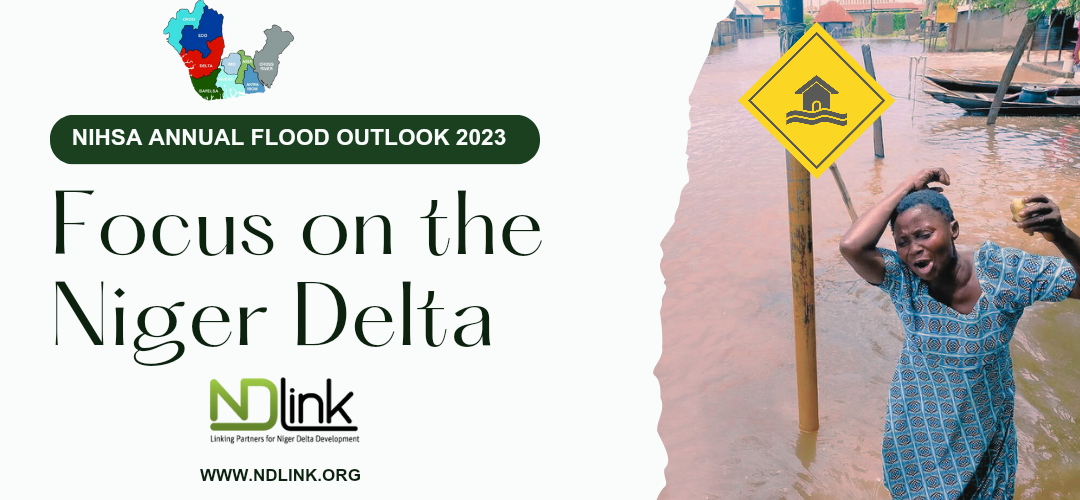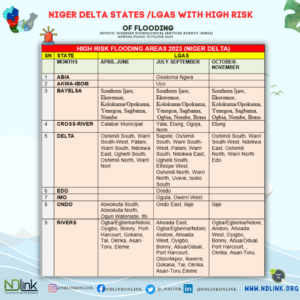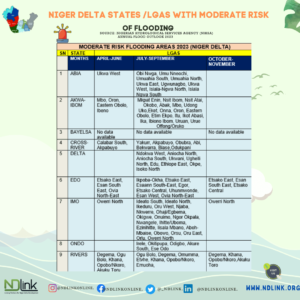Nigeria, a nation of rich cultural diversity and a burgeoning economy, grapples annually with a recurring natural disaster – flooding. This pervasive menace disrupts lives, inflicts substantial economic losses, and displaces thousands of citizens. According to statistics shared by the National Emergency Management Agency,(NEMA), more than 2million individuals were displaced, 83000 buildings were damaged, over 332,000 hectares of cultivated land were destroyed. Also 3,174 people were injured and 662 persons lost their lives in reported flooding incidents in 2022. This is reportedly the worst flooding incident in a decade.
In order to reduce the risk of flooding in Nigeria, the Nigerian Hydrological Services Agency (NIHSA) has over the years continued to inform the Nigerian public and key stakeholders about potential flood scenarios in the country through its insightful yearly publication , the Annual Flood Outlook (AFO).
This publication is prepared using data from the Hydrological Information System Management Network (HYDRONET) which is a system of weather data collection platforms nationwide.
Based on this report, the statistics for the year 2023 are also concerning as the Nigerian Hydrological Services Agency (NIHSA), in its 2023 Annual Flood Outlook (AFO), identified 66 Local Government Areas (LGAs) at high risk of flooding from April to June, 148 LGAs from July to September, and 100 LGAs from October to November. Moreover, 41 LGAs are situated in Moderate Flood-risk Areas from April to June, 199 LGAs from July to September, and 72 LGAs from October to November.
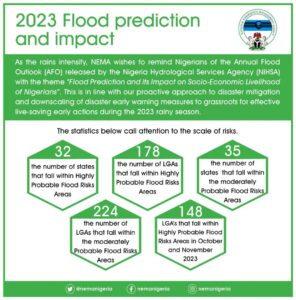
The Niger Delta region due to its Topography is particularly at risk. States like Bayelsa, Delta, and Rivers along the coastal area face heightened risks due to rising sea levels. This article references the data from the Annual flood Outlook for 2023 and highlights States and communities within the Niger Delta facing high risk of flooding and moderate risks of flooding respectively.
According to this report, the 9 Niger Delta States fall within Hydrological Area V (Niger South) which includes Bayelsa, Delta, Edo, Imo and Rivers, Hydrological Area VI (Western Littoral) which includes Ondo Edo and parts of Delta State, Hydrological Area VII (Eastern Littoral) Abia, Akwa-Ibom, Cross River and also parts of Imo and Rivers State.
Data pertaining to the Niger Delta region is contained in pages 39-40, 43-48, 53-55 of NIHSA Annual Flood Outlook 2023
The table below and figure outlines the communities in the Niger Delta which face a high risk of flooding in the months indicated.
| HIGH RISK FLOODING AREAS 2023 (NIGER DELTA) (Source NIHSA Flooding outlook for 2023) | ||||
| SN | STATE | LGAS | ||
| MONTHS | APRIL-JUNE | JULY-SEPTEMBER | OCTOBER-NOVEMBER | |
| 1 | ABIA | Osisioma Ngwa | ||
| 2 | AKWA-IBOM | Uyo | ||
| 3 | BAYELSA | Southern Ijaw,
Ekeremor, Kolokuma/Opokuma, Yenegoa, Sagbama, Nembe |
Southern Ijaw,
Ekeremor, Kolokuma/Opokuma, Yenegoa, Sagbama, Ogbia, Nembe, Brass |
Southern Ijaw, Ekeremor,
Kolokuma/Opokuma, Yenegoa, Sagbama, Ogbia, Nembe, Brass |
| 4 | CROSS-RIVER | Calabar Municipal | Yala, Etung, Ogoja,
Ikom |
Etung |
| 5 | DELTA | Oshimili South, Warri
South-West, Patani, Warri South, Ndokwa East, Ughelli South, Oshimili North, Warri Nort |
Sapele, Oshimili
South, Warri South- West, Patani, Warri South, Ndokwa East, Ughelli South, Ethiope West, Oshimili North, Warri North, Uvwie, Isoko South |
Oshimili South, Warri South-West, Ndokwa East, Oshimili
North, Warri North Edo |
| 6 | EDO | Oredo | ||
| 7 | IMO | Oguta, Owerri West | ||
| 8 | ONDO | Abeokuta South, Abeokuta North, Ogun Waterside, Ifo | Ondo East, Ilaje | Ilaje |
| 9 | RIVERS | Ogba/Egbema/Ndoni, Oyigbo, Bonny, Port-Harcourt, Gokana, Tai, Okrika, Asari-Toru, Eleme | Ahoada East, Ogba/Egbema/Ndoni, Andoni, Ahoada West, Oyigbo, Bonny, Abua/Odual, Port Harcourt, Obio/Akpor, Ikwerre, Gokana, Tai, Okrika, Asari-Toru,Eleme | Ogba/Egbema/Ndoni, Andoni, Ahoada West, Oyigbo, Bonny, Abua/Odual, Port Harcourt, , Okrika, Asari-Toru, |
The table below and figure outlines the communities in the Niger Delta which face a moderate risk of flooding in the months indicated.
| MODERATE RISK FLOODING AREAS 2023 (NIGER DELTA) | ||||
| SN | STATE | LGAS | ||
| MONTHS | APRIL-JUNE | JULY-SEPTEMBER | OCTOBER-NOVEMBER | |
| 1 | ABIA | Ukwa West | Obi Nwga, Umu Nneochi, Umuahia South, Umuahia North, Ukwa East, Ugwunagbo, Ukwa West, Isiala-Ngwa North, Isiala Ngwa South | |
| 2 | AKWA-IBOM | Mbo, Oron, Eastern Obolo, Ibeno | Mkpat Enin, Nsit Ibom, Nsit Atai, Okobo, Abak, Mbo, Udong Uko,Eket, Onna, Oron, Eastern Obolo, Etim Ekpo, Itu, Ikot Abasi, Ika, Ibiono Ibom, Uruan, Urue Offong/Oruko | |
| 3 | BAYELSA | No data available | No data available | No data available |
| 4 | CROSS-RIVER | Calabar South, Akpabuyo | Yakurr, Akpabuyo, Obubra, Abi, Bekwarra, Biase,Odukpani | |
| 5 | DELTA | Ndokwa West, Aniocha North, Aniocha South, Ukwani, Ughelli North, Edu, Ethiope East, Okpe, Isoko North
|
||
| 6 | EDO | Etsako East, Esan South East, Ovia North-East | Ikpoba-Okha, Etsako East, Esaann South-East, Egor, Etsako Central, Uhunmwonde, Esan West, Ovia North-East | Etsako East, Esan South East, Etsako Central |
| 7 | IMO | Owerri North | Ideato South, Ideato North, Ikeduru, Oru West, Njaba, Nkwerre, Ohaji/Egbema, Okigwe, Onuimo, Ngor Okpala, Nwangele, Ihitte/Uboma, Ezinihitte, Iisala Mbano, Aboh-Mbaise, Obowo, Orsu, Oru East, Orlu, Owerri North | Owerri North |
| 8 | ONDO | Irele, Okitipupa, Odigbo, Akure South, Ese Odo | ||
| 9 | RIVERS | Degema, Ogu Bolo, Khana, Opobo/Nkoro, Akuku Toru | Ogu Bolo, Degema, Omumma, Etvhe, Khana, Opobo/Nkoro, Emuoha, | Degema, Khana, Opobo/Nkoro,Akuku Toru |
CAUSES OF FLOODING
- Rains and Climate Change: Nigeria’s geographical location makes it vulnerable to seasonal heavy rainfall, particularly during the wet season. Climate change exacerbates these patterns, leading to more intense and unpredictable rainfall.
- Poor Urban Planning: Rapid urbanization has resulted in the construction of buildings and infrastructure on floodplains, blocking natural drainage systems. This haphazard urban development worsens flooding in cities.
- Deforestation: Rampant deforestation has diminished the country’s natural defenses against floods. Trees play a crucial role in absorbing rainwater and stabilizing soil, but deforestation has significantly reduced their numbers.
- Inadequate Drainage Systems: Many urban areas lack proper drainage systems to channel rainwater away. This leads to water stagnation and flooding during heavy rains. Indiscriminate dumping of garbage into drainages remains pervasive and also contributes to worsening the flooding situation.
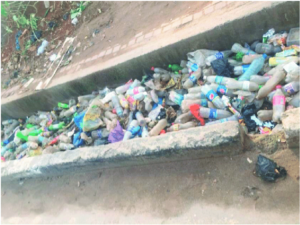
CONSEQUENCES OF FLOODING
- Humanitarian Crisis: Flooding displaces thousands of Nigerians annually, leading to a humanitarian crisis. People lose their homes, livelihoods, and sometimes even their lives.
- Economic Losses: Flooding wreaks havoc on the economy. Crops are destroyed, infrastructure damaged, and businesses disrupted. This has a long-term impact on food security and economic stability.
- Health Risks: Stagnant floodwater becomes a breeding ground for diseases like cholera and malaria. The health risks increase significantly during and after flooding.
- Disrupted Education: Schools often close during floods, disrupting the education of countless children and teenagers.
EFFORTS TO MITIGATE FLOODING
- Early Warning Systems: The Nigerian government, with the support of international organizations, can improve its flood early warning systems. These systems help in timely evacuation and disaster preparedness.
- Infrastructure Investment: There should be increased investment in flood-resistant infrastructure, including better drainage systems and the construction of dams and reservoirs to regulate water flow.
- Reforestation Initiatives: Environmental conservation efforts should be made to combat deforestation. Tree planting campaigns aim to restore the country’s natural defenses against floods.
- Community Education: NGOs and government agencies should educate communities about flood risks and how to prepare for and respond to flooding.
Conclusion:
Flooding remains a significant challenge in Nigeria, affecting millions of lives each year. However, with a combination of improved infrastructure, better urban planning, climate change mitigation, and community education, Nigeria can take steps toward minimizing the impact of flooding. The battle against flooding is ongoing, but with concerted efforts, Nigeria can hope for a future where its citizens are less vulnerable to this recurring natural disaster.
To read the full report, you can download it from our resources page using this link: Nigeria’s Annual Flood Outlook Report for 2023(NIHSA) – Linking Partners for Niger Delta Development (ndlink.org)
For more insights on the Nexus between Conflicts and Flooding, read this article by Ediye Bassey: The Conflict Aftermaths of Flooding in Nigeria – Linking Partners for Niger Delta Development (ndlink.org)
